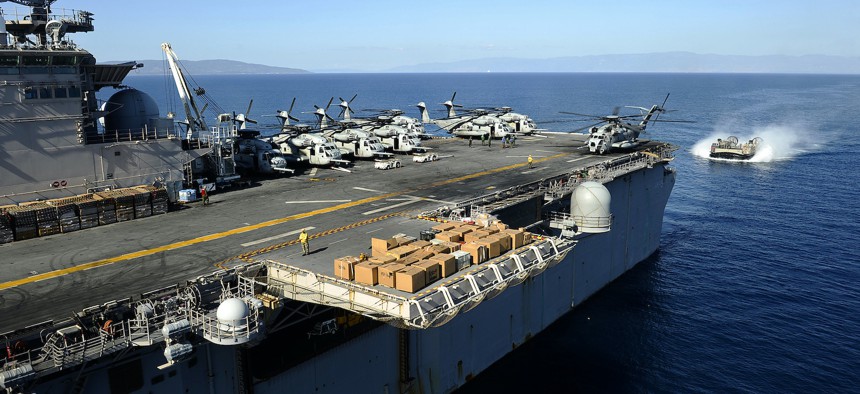
A landing craft air cushion assigned to Assault Craft Unit 4, makes its way toward the well deck entrance of the multi-purpose amphibious assault ship USS Bataan after delivering humanitarian aid and supplies ashore near Grand Goave, Haiti, in 2010. Courtesy photo
‘We Didn’t Have the Ships’ to Send ‘Best Option’ to Help Earthquake Victims, Commandant Says
Incident comes a year after maintenance problems delayed the 22nd MEU’s deployment to Europe.
The Marines could not send a large crisis-response unit to Turkey after its devastating earthquake because there weren’t any amphibious ships in the region, the Marine Corps commandant said Wednesday, raising new concerns about the service’s ability to carry out one of its core missions.
“We didn't have a Marine Expeditionary Unit, a MEU, nearby that could respond…I owe the secretary of defense, the President—we joint chiefs owe them options…all the time. Here, I felt like the best option, we couldn't offer them because we have the Marines and the equipment and they're trained, we didn't have the ships,” Gen. David Berger said during an interview with Defense One.
The incident comes a year after Marines with orders to deploy to Europe were delayed because some of the amphibious readiness group ships they were supposed to use were not out of maintenance in time.
In the immediate aftermath of the earthquake, victims quickly needed basic supplies such as water, medicine, and equipment to deal with the rubble, Berger said, but without the added burden of more people ashore, which a MEU aboard an amphibious ship could provide.
“We would have liked for a MEU/ARG, or amphibious ready group, to be in the Mediterranean all the time, and then they could get there quickly to a NATO member like Turkey, but we couldn't do that,” he said.
The military has provided other help to Turkey as part of the U.S.’ response to the Feb. 6 earthquake, including air transport of people and equipment.
The Marine Corps needs at least 31 amphibious ships, or more risk will be passed to combatant commanders, Marines, and sailors, Gen. Eric Smith, the Marines’ assistant commandant, said in a keynote speech at WEST 2023 in San Diego on Tuesday.
“So 31 is the answer, and we can't accept less. And when it does, we just have to highlight that there's increased risk now for us, for those American citizens waiting to be evacuated for humanitarian assistance / disaster relief operations,” Smith said.
Pointing to Smith’s comments, Berger said the Turkey incident is an example of what can happen when the Marine Corps has fewer amphibious ships than needed.
“Anything less than that, anything less, then the combatant commanders start to accept risk where they can't get to something, they can't deter something. And at that point, there's risk,” he said.
The Navy already has the minimum of 31 amphibious ships; however, its 30-year shipbuilding plan would have reduced the number to a low of 24 next year before bringing it back up to 31 by 2030. Congress last year intervened by putting the minimum of 31 into law.
Last February, amid growing concerns of Russia’s buildup of forces along Ukraine’s border, the 22nd MEU was ordered to deploy to Europe. But while the Marines were ready to go, the three warships of the USS Kearsarge Amphibious Ready Group were not, said Lt. Gen. Karsten Heckl, the commanding general of Marine Corps Combat Development Command and deputy commandant for Combat Development and Integration.
“The bottom line is, we should have been there and had that available to the combatant commander and we weren't,” Heckl told Defense One in April.
At the time, Heckl said the problem deploying the Kearsarge ARG illustrated the state of readiness of the entire amphibious Navy, and warned that a similar incident could happen again.
“And in the Navy's defense, I understand, you know, they have Columbia [submarine], the nuclear triad, and amphibs just unfortunately fall out on the bottom,” Heckl said. “But the reality is that the mission sets that a MEU/ARG is most likely to do are very real, they're fairly regular, and pretty frequent. And unfortunately, we don't have the assets right now to respond like we should.”
The Marine Corps supports any funding that addresses the Navy’s ship maintenance and readiness problems, Berger said.
“Every dollar that goes into maintenance for ships is a good dollar spent. Amphibious ships, destroyers, submarines, all of it. We have to resource that, we have to fund that,” he said. “And the [chief of naval operations] has been pretty open about the unacceptable backlogs in repairs and times to get a ship out of the yards. He's been very forthright about, hey, that has to improve to build our readiness.”


